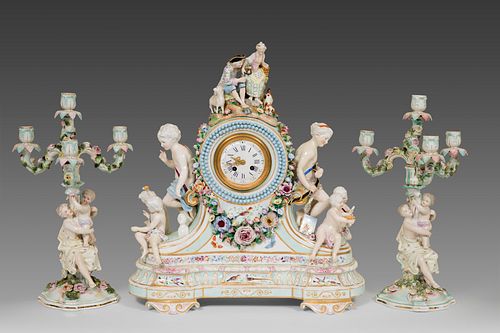Garrison; End of XIX century. Saxony porcelain.
Lot 96
About Seller
Setdart Auction House
Carrer Aragó 346
Barcelona
Spain
Setdart Subastas was born in 2004 and is currently the first online art auction in Spain with solidity, prestige and reliability guaranteed by our more than 60,000 users. Setdart has a young, dynamic and enterprising team ready to successfully manage the purchase and sale of art works through custom...Read more
Categories
Estimate:
EUR€5,000 - EUR€6,000
$5,376.34 - $6,451.61
Absentee vs Live bid
Two ways to bid:
- Leave a max absentee bid and the platform will bid on your behalf up to your maximum bid during the live auction.
- Bid live during the auction and your bids will be submitted real-time to the auctioneer.
Bid Increments
| Price | Bid Increment |
|---|---|
| EUR€0 | EUR€10 |
| EUR€200 | EUR€25 |
| EUR€500 | EUR€50 |
| EUR€1,000 | EUR€100 |
| EUR€3,000 | EUR€200 |
| EUR€5,000 | EUR€500 |
| EUR€10,000 | EUR€1,000 |
| EUR€20,000 | EUR€2,000 |
| EUR€50,000 | EUR€5,000 |
About Auction
By Setdart Auction House
Nov 10, 2021
Set Reminder
2021-11-10 08:00:00
2021-11-10 08:00:00
America/New_York
Bidsquare
Bidsquare : 19th & 20th Century paintings and Decorative Arts
https://www.bidsquare.com/auctions/setdart-auction-house/19th-20th-century-paintings-and-decorative-arts-7800
Setdart Auction House sofia@setdart.com
Setdart Auction House sofia@setdart.com
- Lot Description
Garrison; End of XIX century. Saxony porcelain. Presents faults in the porcelain and in the leg of the cherub. Measurements: 60 x 50 x 24 cm; 47 x 24 x 25 x 25 cm. Garrison composed of a table clock and two candlesticks. The clock, made of porcelain, has a prismatic base structure supported by four legs. In the center is the dial with Roman numerals in black. The design of the structure of the case is simple, following the format of the watch itself. However, this body has an ornamental sculptural pattern of profuse character, arranging figurines on the sides and in the upper area of the clock. A set of three-light candelabra (the central one higher and in the center), placed on a base with forms reminiscent of the Rococo Rococo of the 18th century, complete the decoration, as do the rest of the decorative elements: the couple that is placed on both candelabra (formed by a lady and a child, which seems to represent a little love), the roses of different colors that populate and almost hide the foot and other elements of the pieces in some flowers, made in relief, etc. The style of the figures and the shades are very reminiscent of the works popularized by the Meissen Manufactory, which was the first European factory to produce authentic porcelain. The manufacture was started by the scientist Ehrenfried Walther von Tchirnhaus in 1708, and after his untimely death his work was continued by Joahnn Friedrich Böttger, who remained practically imprisoned on the factory premises in order to protect the secret of the porcelain formula. Meissen porcelain production began in 1710, one year after the manufactory was founded by Augustus the Strong, and soon achieved great fame throughout Europe. After an initial production in rococo style, which evolved towards neoclassical in the 1750s, in the 19th century we witnessed a new style known as "second rococo", inspired by the first productions of the manufactory, which coexisted with other historicisms, among them the round sculpture, mainly in enameled porcelain, following models of both rococo and neoclassical.
- Shipping Info
-
In-house shipping available. Please inquire at admin@setdart.com.
-
- Buyer's Premium



 EUR
EUR CAD
CAD AUD
AUD GBP
GBP MXN
MXN HKD
HKD CNY
CNY MYR
MYR SEK
SEK SGD
SGD CHF
CHF THB
THB

















